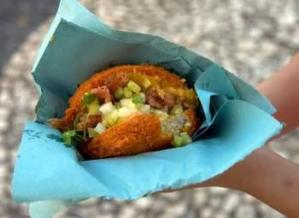I am an English teacher, linguist, and polyglot.
Let me be perfectly clear, before we go any further, that the latter two do NOT necessarily go hand in hand. It was in fact my own misunderstanding of linguistics that led to me majoring in it in college, only to struggle through the basic core courses, but I digress.

Nevertheless, now that I am a graduated linguist, I pay attention to language in a way that I did not before, particularly the ‘mistakes’ that occur amongst learners of a second language.
As teacher, I have lots of experience with the output errors that ESL learners produce. My friends and colleagues here in Brazil often ask me to help them with their English, but there is one mistake that I just cannot bring myself to correct.
Brazilians have this beautiful way of expressing a desire to ‘know’ a place; that is, to go and visit a destination previously unknown.
Where native speakers of English say, “I want to go to Japan,” or “I’d like to visit London,” my Portuguese speaking-partner talks to me about wanting to ‘know’ Russia, Australia, and the like.
So, allow me to tell you about how I came to ‘know’ Salvador, Bahia, Brazil.

Once the capital of the country and now Brazil‘s fourth biggest city (according to Wikipedia), Salvador is a truly a feast for the senses, full of beautiful architecture, innovative street art, sweeping beaches, open markets, and delicious Baiano cuisine.
Food being my number one priority on any travel excursion, I was eager to try tapioca in the place where it originated (I was not disappointed.)
The tapioca of Brazil is prepared much differently than tapioca pudding that’s in the United States. In Bahia and throughout Brazil, tapioca flour is used as a staple thickener and base to make a wrap or tortilla.

I ate tapioca stuffed with savory foods for the first time here, my favorite combination so far being shrimp and cheese. I haven’t eaten the sweet styles yet, but they’re on my list to try.
Salvador is also where I fell in love with acarajé, a local delicacy of fried black beans and shrimp. I’d tried it first in Sampa and really could not get down with the texture, but enjoying it on the beaches of Bahia, along with a cold beer, was exactly what my body needed post stand-up paddle boarding (or any time, really).
Oh, and did I mention the crab? They’re smaller than the Alaskan King or Snow Crab I dine on in the States, but what these bad boys lack in size, they make up for in flavor. Delicious and reasonably priced, I’d eat crab every day in Bahia if I could.
 Aside from the food, there are lots of things to see and do in the city:
Aside from the food, there are lots of things to see and do in the city:

Feira São Joaquim
São Joaquim is a grid of narrow alleys chock full of everything you could ever need. It is a proper locals’ market, with live animals for sale and the many fruits, spices and dried foods indigenous to Brazil. This is where I managed to find a small, hand-carved carranca to take as a souvenir (I’ve been coveting one ever since I saw them for the first time at the Museum of Afro-Brazilian history in São Paulo.)
Baía de Todos os Santos
Location, location, location: it’s as crucial in history as it is in real estate, and the place Salvador occupies on the Brazilian coast was a key factor in how the city came to be an important trading and transport hub. Salvador is positioned halfway down the country’s coast on the Baía de Todos os Santos, or Bay of All Saints. It’s the largest bay in Brazil, even bigger than Guanabara Bay in Rio de Janeiro.
Elevador Lacerda
Salvador is a city on two levels. To connect the high and low parts of the city, an elevator was built in 1873. In addition to bridging an 85-meter escarpment, taking the public up and down in thirty seconds, hundreds of times a day, this lovely lift gives breathtaking views of the bay and the city.

Pelourinho
In 1549, when the Portuguese landed on Brazil’s coast, they built the city of Salvador da Bahia on the shore of the Bay of All Saints.
Looking at the beautiful European architecture and colorful facades that adorn the historic center, one could be excused for not realizing the dark history of a place that is now a UNESCO World Heritage site.
Pelourinho, which means pillory, was the place where slaves were publicly flogged.
Slavery in Brazil lasted for 300 years, and it imported some 4 million Africans to the country, with the largest proportion of these ending up in the state of Bahia.
By the time it was abolished in 1888 (making Brazil the last country in the Americas to do so), an estimated four million slaves had been imported from Africa to Brazil, 40% of the total number of slaves brought to the Americas.

São Marcelo Fort
Looking down from the upper city and the Elevador Lacerda, you’ll be quick to spot the large cylindrical São Marcelo fort. Described by novelist Jorge Amado as “the belly button of Bahia,” the fort was a crucial Portuguese defensive point in the 17th century. It’s no longer open to the public, but we managed to see it from afar when we rode by on our awesome boat tour.
Praia Porto da Barra
Hands-down the best place to watch the sun set on Salvador. Go there.
Rio Vermelho
Fun area to hang out at night, full of yummy street food, with great people watching opportunities!
Mi’iwi [that’s all for now]
